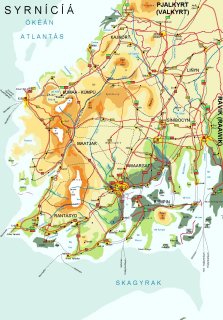Flora and Fauna
Due to the high variety in landscapes, from rough mountainous areas with glaciers and rocks to gently sloping hills covered with friendly forests, Surnichia has a wide diversity of plant and animal species.
Flora
The most common forests found throughout Surnichia are pine forests. From a macro perspective they belong to the boreal forests, a vast area of coniferous forests in the subarctic region stretching all the way to eastern Russia, and further to Alaska and Canada. These forests are home to various kinds of herbs and ferns, to blueberries (Vaccinium myrtillus), raspberries (Rubus idaeus), woodland strawberries (Fragaria vesca) and different sorts of fungi. At higher altitudes, above the tree line, vegetation changes to shrubs and bushes, such as the dwarf birch (Betula nana) and the common juniper (Juniperus communis). On the mountain plateaus one will find marsh plants, heathlands and reindeer lichen (Cladonia rangiferina).
Towards the southern and south-western lowlands, pine forests are more and more superseded by deciduous forests, including tree species such as the oak (Quercus robur and Quercus petraea), the common ash (Fraxinus excelsior), the wych elm (Ulmus glabra), the Norway maple (Acer platanoides), the common hazel (Corylus avellana), the whitebeam (Sorbus aria), and different birch species (Betula).
Fauna
The boreal pine forests are the natural habitat of many different birds and mammals, such as the capercaillie (Tetrao urogallus), different owl species, martens (Martes martes), bats, deer, foxes (Vulpes vulpes) and badgers (Meles meles), to name a few. The woods are also home to the kulawa, a nocturnal rodent species first discovered in 2112 by Heinrich Magsner. It lives high up in the trees and feeds with nuts and berries.
In the north of Surnichia, brown bears (Ursus arctos) can be found. In the mountains, birds of prey, such as the golden eagle (Aquila chrysaetos) and the gyrfalcon (Falco rusticolus) dominate the sky. One of their main preys is the willow grouse (Lagopus lagopus), that inhabits the moorlands and birch forests. Reindeer (Rangifer tarandus) populations can also be found in these areas, especially on the Fjeldovrø plateau.
At the rugged coast and on the many islands of Surnichia many waterfowl have their nests, such as ducks, common murres (Uria aalge) and puffins (Fratercula arctica). Other birds, such as larks, can be found here as well. The seas are populated by numerous fish species, such as pollock (Pollachius virens), mackerel (Scomber scombrus), cod (Gadus morhua), the seawolf (Anarhichas lupus) and flatfish such as the Atlantic halibut (Hippoglossus hippoglossus). Fish found in freshwater, such as salmon (Salmo salar), trout (Salmo trutta), perch (Perca fluviatilis), bream (Abramis brama) and pike (Esox lucius), are native to Surnichia's rivers and lakes.
Reptiles are quite rare in Surnichia, but can be found in the grasslands in the south. Reptiles native to Surnichia include adders (Vipera berus), grass snakes (Natrix natrix) and small lizards. The grasslands are also home to birds like the lapwing (Vanellus vanellus) and the partridge (Perdix perdix).
